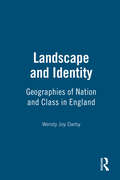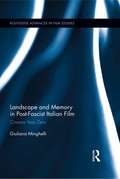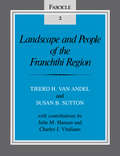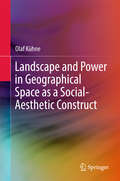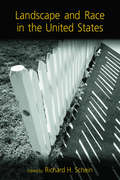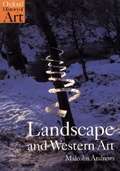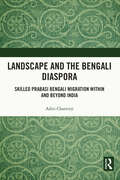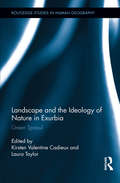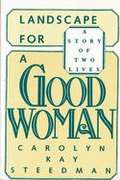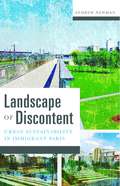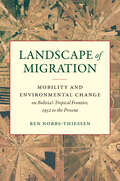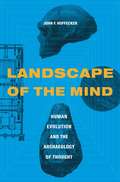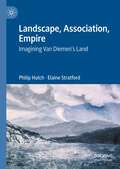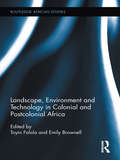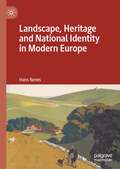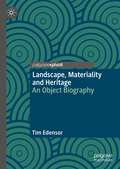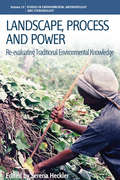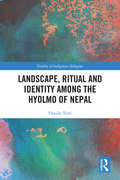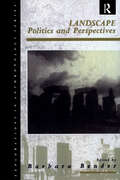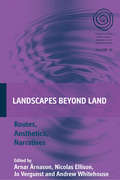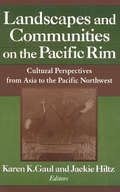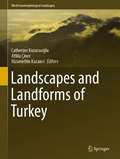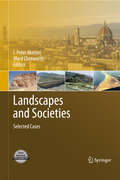- Table View
- List View
Landscape and Identity in the Modern Basque Country, 1800 to 1936 (Routledge Studies in Cultural History)
by Maitane OstolazaLandscape and Identity in the Modern Basque Country, 1800 to 1936 studies the relationship between landscape and modern identities in the Basque Country. Using an interdisciplinary approach that combines cultural history and geography, it analyses the process of historical construction of the Basque landscape, highlighting its multiple political, social and cultural meanings. The book is divided into two parts: the first examines the discourses, images and representations of the Basque landscape; the second examines landscape practices through tourism, hiking and mountaineering. Focusing on the Basque case but establishing numerous connections with comparable phenomena in Western Europe, the book demonstrates that the landscape became a structuring element insofar as it helped shape individual identities while participating in the creation of social links. This book examines the processes of identity construction "from below" by means of new interpretative tools, such as the experience of landscape. This work, originally published in French, brings to an English-speaking audience a crucial issue in the modern history of the Basque Country, namely the cultural construction of a collective identity within the framework of a nation-state, such as Spain, confronted with multiple territorial identities. Approaching this question from the perspective of landscape provides new keys to understanding the processes of nation-building that occurred in Europe in the nineteenth and twentieth centuries.
Landscape and Identity: Geographies of Nation and Class in England (Materializing Culture Ser.)
by Wendy Joy DarbyIn England, perhaps more than most places, people's engagement with the landscape is deeply felt and has often been expressed through artistic media. The popularity of walking and walking clubs perhaps provides the most compelling evidence of the important role landscape plays in people's lives. Not only is individual identity rooted in experiencing landscape, but under the multiple impacts of social fragmentation, global economic restructuring and European integration, membership in recreational walking groups helps recover a sense of community. Moving between the 1750s and the present, this transdisciplinary book explores the powerful role of landscape in the formation of historical class relations and national identity. The author's direct field experience of fell walking in the Lake District and with various locally based clubs includes investigation of the roles gender and race play. She shows how the politics of access to open spaces has implications beyond the immediate geographical areas considered and ultimately involves questions of citizenship.
Landscape and Memory in Post-Fascist Italian Film: Cinema Year Zero (Routledge Advances in Film Studies)
by Giuliana MinghelliThis study argues that neorealism’s visual genius is inseparable from its almost invisible relation to the Fascist past: a connection inscribed in cinematic landscapes. While largely a silent narrative, neorealism’s complex visual processing of two decades of Fascism remains the greatest cultural production in the service of memorialization and comprehension for a nation that had neither a Nuremberg nor a formal process of reconciliation. Through her readings of canonical neorealist films, Minghelli unearths the memorial strata of the neorealist image and investigates the complex historical charge that invests this cinema. This book is both a formal analysis of the new conception of the cinematic image born from a crisis of memory, and a reflection on the relation between cinema and memory. Films discussed include Ossessione (1943) Paisà (1946), Ladri di biciclette (1948), and Cronaca di un amore (1950).
Landscape and People of the Franchthi Region: Fascicle 2, Excavations at Franchthi Cave, Greece (Excavations at Franchthi Cave, Greece)
by Tjeerd H Van Andel Susan B SuttonWith the long-awaited publication of these three volumes we have the first thorough documentation of one of the most important prehistoric sites in the Mediterranean, that of Franchthi Cave in the Argolid Peninsula of Greece." —American Anthropologist... the archaeological and paleoenvironmental data from Franchthi Cave are unique in providing a site-specific record of the cultural responses to great environmental changes." —Quarterly ResearchThis volume describes the evolution of the landscape around Franchthi Cave over 25,000 years, its impact on prehistoric inhabitants, and theirs on it.
Landscape and Power in Geographical Space as a Social-Aesthetic Construct
by Olaf KühneThis book examines the power definiteness of landscape from a social constructivist perspective with a particular focus on the importance of aesthetic concepts of landscape in development. It seeks to answer the question of how societal notions of landscape emerge, how they are individually updated and how these ideas affect the use and design of physical space. It also analyzes how physical manifestations of societal activity impact on understandings of individual and societal landscapes and addresses the essential aspect of the social construction of landscape, cultural specificity, which in turn is discussed in the context of the expansion of a western landscape concept. The book offers an unprecedented, comprehensive and detailed examination of societal power relations in the context of landscape development. The numerous case studies from the physical manifestation of modern spatial planning in the United States, the power discourses concerning the design of model railway landscapes, and the medial production of stereotypical landscape notions shed light on the complex and multilayered interactions of collective and individual landscape references. It is a valuable resource for geographers, sociologists, landscape architects, landscape planners and philosophers.
Landscape and Race in the United States
by Richard H. ScheinLandscape and Race in the United States is the definitive volume on racialized landscapes in the United States. Edited by Richard Schein, each essay is grounded in a particular location but all of the essays are informed by the theoretical vision that the cultural landscapes of America are infused with race and America's racial divide. While featuring the black/white divide, the book also investigates other social landscapes including Chinatowns, Latino landscapes in the Southwest and white suburban landscapes. The essays are accessible and readable providing historical and contemporary coverage.
Landscape and Western Art
by Malcolm AndrewsWhat is landscape? How does it differ from 'land'? Does landscape always imply something to be pictured, a scene? When and why did we begin to cherish images of nature? What is 'nature'? Is it everything that isn't art, or artefact? This book explores many fascinating issues raised by the great range of ideas and images of the natural world in Western art since the Renaissance. Using a thematic structure many issues are examined, for instance: landscape as a cultural construct; the relationship between landscape as accessory or backdrop and landscape as the chief subject; landscape as constituted by various practices of framing; the sublime and ideas of indeterminacy; landscape art as picturesque or as exploration of living processes. These issues are raised and explored in connection with Western cultural movements, and within a full international and historical context. Many forms of landscape art are included: painting, gardening, panorama, poetry, photography, and art. The book is designed to both take stock of recent interdisciplinary debates and act as a stimulus to rethinking our assumptions about landscape.
Landscape and the Bengali Diaspora: Skilled Prabasi Bengali Migration within and beyond India
by Aditi ChatterjiBengalis have been great travellers for centuries and are famous for recreating their way of life wherever they go. This book critically analyses skilled Bengali migration within and beyond India and looks at landscapes created by the Bengali diaspora beyond the terrain of their homeland, ranging from those of nostalgia and imagination (Durga Puja/Saraswati Puja) to those of subjugation and loss of identity. This book demonstrates the relationship between landscape and diaspora in terms of perception, imagination, space and place, ethnicity, race, caste, and class. With case studies from Delhi, Mumbai, Bengaluru, Dehra Dun, Oxford, Aberdeen, New York, and the Bay Area (USA), it brings together themes like evolution of the Bengali diaspora, transnationalism and identity, stratification and segregation, urban social space, adaptation and assimilation, and questions of discrimination from other communities. Drawing on ethnographic accounts of over 300 skilled Bengalis, the book will be an essential read for scholars and researchers of diaspora studies, urban studies, ethnic studies, migration studies, geography, sociology, history, and political studies.
Landscape and the Ideology of Nature in Exurbia: Green Sprawl (Routledge Studies in Human Geography #39)
by Laura Taylor Kirsten Valentine CadieuxThis book explores the role of the ideology of nature in producing urban and exurban sprawl. It examines the ironies of residential development on the metropolitan fringe, where the search for “nature” brings residents deeper into the world from which they are imagining their escape—of Federal Express, technologically mediated communications, global supply chains, and the anonymity of the global marketplace—and where many of the central features of exurbia—very low-density residential land use, monster homes, and conversion of forested or rural land for housing—contribute to the very problems that the social and environmental aesthetic of exurbia attempts to avoid. The volume shows how this contradiction—to live in the green landscape, and to protect the green landscape from urbanization—gets caught up and represented in the ideology of nature, and how this ideology, in turn, constitutes and is constituted by the landscapes being urbanized.
Landscape for a Good Woman: A Story of Two Lives
by Carolyn Kay SteedmanThis book is about lives lived out on the borderlands, lives for which the central interpretative devices of the culture don't quite work. It has a childhood at its centre - my childhood, a personal past - and it is about the disruption of that fifties childhood by the one my mother had lived out before me, and the stories she told about it.
Landscape of Discontent: Urban Sustainability in Immigrant Paris (A Quadrant Book)
by Andrew NewmanOn a rainy day in May 2007, the mayor of Paris inaugurated the Jardins d&’Éole, a park whose completion was hailed internationally as an exemplar of sustainable urbanism. The park was the result of a hard-fought, decadelong protest movement in a low-income Maghrebi and African immigrant district starved for infrastructure, but the Mayor&’s vision of urban sustainability was met with jeers. Drawing extensively from immersive, firsthand ethnographic research with northeast Paris residents, as well as an analysis of green architecture and urban design, Andrew Newman argues that environmental politics must be separated from the construct of urban sustainability, which has been appropriated by forces of redevelopment and gentrification in Paris and beyond. France&’s turbulent political environment also provides Newman with powerful new insights into the ways in which multiethnic coalitions can emerge⎯even amid overt racism and Islamophobia⎯in the struggle for more just cities and more inclusive societies. A tale of multidimensional political efforts, Landscape of Discontent cuts through the rhetoric of green cities to reveal the promise that environmentalism holds for urban communities anywhere.
Landscape of Migration: Mobility and Environmental Change on Bolivia's Tropical Frontier, 1952 to the Present (Flows, Migrations, and Exchanges)
by Ben Nobbs-ThiessenIn the wake of a 1952 revolution, leaders of Bolivia's National Revolutionary Movement (MNR) embarked on a program of internal colonization known as the "March to the East." In an impoverished country dependent on highland mining, the MNR sought to convert the nation's vast "undeveloped" Amazonian frontier into farmland, hoping to achieve food security, territorial integrity, and demographic balance. To do so, they encouraged hundreds of thousands of Indigenous Bolivians to relocate from the "overcrowded" Andes to the tropical lowlands, but also welcomed surprising transnational migrant streams, including horse-and-buggy Mennonites from Mexico and displaced Okinawans from across the Pacific.Ben Nobbs-Thiessen details the multifaceted results of these migrations on the environment of the South American interior. As he reveals, one of the "migrants" with the greatest impact was the soybean, which Bolivia embraced as a profitable cash crop while eschewing earlier goals of food security, creating a new model for extractive export agriculture. Half a century of colonization would transform the small regional capital of Santa Cruz de la Sierra into Bolivia's largest city, and the diverging stories of Andean, Mennonite, and Okinawan migrants complicate our understandings of tradition, modernity, foreignness, and belonging in the heart of a rising agro-industrial empire.
Landscape of the Mind: Human Evolution and the Archaeology of Thought
by John HoffeckerIn Landscape of the Mind, John F. Hoffecker explores the origin and growth of the human mind, drawing on archaeology, history, and the fossil record. He suggests that, as an indirect result of bipedal locomotion, early humans developed a feedback relationship among their hands, brains, and tools that evolved into the capacity to externalize thoughts in the form of shaped stone objects. When anatomically modern humans evolved a parallel capacity to externalize thoughts as symbolic language, individual brains within social groups became integrated into a "neocortical Internet," or super-brain, giving birth to the mind.Noting that archaeological traces of symbolism coincide with evidence of the ability to generate novel technology, Hoffecker contends that human creativity, as well as higher order consciousness, is a product of the superbrain. He equates the subsequent growth of the mind with human history, which began in Africa more than 50,000 years ago. As anatomically modern humans spread across the globe, adapting to a variety of climates and habitats, they redesigned themselves technologically and created alternative realities through tools, language, and art. Hoffecker connects the rise of civilization to a hierarchical reorganization of the super-brain, triggered by explosive population growth. Subsequent human history reflects to varying degrees the suppression of the mind's creative powers by the rigid hierarchies of nationstates and empires, constraining the further accumulation of knowledge. The modern world emerged after 1200 from the fragments of the Roman Empire, whose collapse had eliminated a central authority that could thwart innovation. Hoffecker concludes with speculation about the possibility of artificial intelligence and the consequences of a mind liberated from its organic antecedents to exist in an independent, nonbiological form.
Landscape – Tourism – Food: Contributions to European Touristscapes and Foodscapes (RaumFragen: Stadt – Region – Landschaft)
by Olaf Kühne Liliana DumitracheLandscape and food - there is hardly a form of tourism that is not oriented towards one or the other (often both). As a result of this close connection, our anthology explores the different facets of these links. Drawing on the concepts of Touristscapes and Foodscapes, an international group of authors provide theoretical considerations as well as overviews of larger spatial units and local and thematic case studies. What the contributions have in common is their focus on a synthetic-landscape view of the topics dealt with, ranging from the investigation of post-socialist material substrates for the development of current touristscapes and foodscapes, to the touristic use of socialist heritage and phenomena of dark tourism, to the development of gastronomic offers and their significance for the construction of identities, but also the staging of places for social media contexts. Contributions from authors, particularly from the fields of geography, economics and sociology, highlight the diversity of perspectives on the rapidly developing research field of landscape, food and tourism.
Landscape, Association, Empire: Imagining Van Diemen’s Land
by Elaine Stratford Philip HutchThis book tells a compelling story about invasion, settler colonialism, and an emergent sense of identity in place, as seen through topographical and landscape images by seven fascinating artists. Their ways of imagining the Vandemonian landscape are part of a much larger story about how aesthetic forces shaped empire and colony, place and migration, and people’s lives. They remain intriguing through-lines of global significance and local meaning.
Landscape, Environment and Technology in Colonial and Postcolonial Africa (Routledge African Studies)
by Toyin Falola Emily BrownellThis volume seeks to identify and examine two categories of colonial and postcolonial knowledge production about Africa. These two broad categories are "environment" and "landscape," and both are useful and problematic to explore. Discussions about African environments often concentrate on Africans as perpetrators of their own land, causing degradation from lack of knowledge and technology. "Landscape" defines the category of knowledge produced by foreigners about Africa, where Africans remain part of the scenery and yield no agency over their surroundings. To flesh out these categories and explore their creation and how they have been deployed to shape colonial and postcolonial discourses on Africa, this volume investigates the "technological pastoral," the points of convergence and conflict between Western notions of pastoral Africa and the introduction of colonial technology, scientific ideas and commodification of land and animals.
Landscape, Heritage and National Identity in Modern Europe
by Hans RenesThis book describes the way in which landscape and landscape heritage have been – and still are – used to define national identities. It shows how national narratives use different types of landscapes. Some nations use nature as their main point of reference, partly to circumcise conflicts between different ethnic groups. Other nations use agrarian landscapes, that are often describes as timeless and ‘rooted’. Again other nations use history as a major sources for defining identities. In these cases, myths of origins, ‘Golden Ages’ or wars and conflicts deliver the materials for national narratives. The final section describes how nation states developed new urban as well as rural landscapes as national showpieces. As landscapes are an important but under-researched aspect of nation-building, this book fills a gap in the study of nationalism.
Landscape, Materiality and Heritage: An Object Biography
by Tim EdensorThis book focuses on a single artefact, the Barochan Cross, a ninth century stone sculpture in Renfrewshire, Scotland. Exploring the changing stories, meanings, locations, uses and feelings of the sculpture, Tim Edensor adopts a broad temporal frame across twelve centuries that moves away from a periodisation that solely considers its original meanings and uses. Narrating the shifting ways in which the Barochan Cross has been moved, utilised, cared for, interpreted, encountered, sensed, copied and appropriated allows for a sophisticated yet highly accessible discussion about its changing relationships with the physical and conceptual landscapes in which it has been situated. This book thus expands the ways in which landscape might be conceptualised, revealing how artefacts can inform future critical thinking about heritage and bringing an important contribution to theories about material culture and landscape.
Landscape, Process And Power
by Serena HecklerIn recent years, the field of study variously called local, indigenous or traditional environmental knowledge (TEK) has experienced a crisis brought about by the questioning of some of its basic assumptions. This has included reassessing notions that scientific methods can accurately elicit and describe TEK or that incorporating it into development projects will improve the physical, social or economic well-being of marginalized peoples. The contributors to this volume argue that to accurately and appropriately describe TEK, the historical and political forces that have shaped it, as well as people's day-to-day engagement with the landscape around them must be taken into account. TEK thus emerges, not as an easily translatable tool for development experts, but as a rich and complex element of contemporary lives that should be defined and managed by indigenous and local peoples themselves.
Landscape, Ritual and Identity among the Hyolmo of Nepal: The Buddha and the Drum (Vitality of Indigenous Religions)
by Davide TorriThis book analyses the social, political and religious life of the Hyolmo people of Nepal. Highlighting patterns of change and adaptation, it addresses the Shamanic-Buddhist interface that exists in the animated landscape of the Himalayas. Opening with an analysis of the ethnic revival of Nepal, the book first considers the Himalayan religious landscape and its people. Specific attention is then given to Helambu, home of the Hyolmo people, within the framework of Tibetan Buddhism. The discussion then turns to the persisting shamanic tradition of the region and the ritual dynamics of Hyolmo culture. The book concludes by considering broader questions of Hyolmo identity in the Nepalese context, as well as reflecting on the interconnection of landscape, ritual and identity. Offering a unique insight into a fascinating Himalayan culture and its formation, this book will be of great interest to scholars of indigenous peoples and religion across religious studies, Buddhist studies, cultural anthropology and South Asian studies.
Landscape: Politics and Perspectives (Explorations in Anthropology)
by Barbara BenderThis book is about the complexity and power of landscape. The authors - geographers, anthropologists and archaeologists - explore landscape as something subjective that alters through time and space and that is created by people through their experience and contact with the world around them.
Landscapes Beyond Land: Routes, Aesthetics, Narratives
by Ellison Árnason Vergunst WhitehouseLand is embedded in a multitude of material and cultural contexts, through which the human experience of landscape emerges. Ethnographers, with their participative methodologies, long-term co-residence, and concern with the quotidian aspects of the places where they work, are well positioned to describe landscapes in this fullest of senses. The contributors explore how landscapes become known primarily through movement and journeying rather than stasis. Working across four continents, they explain how landscapes are constituted and recollected in the stories people tell of their journeys through them, and how, in turn, these stories are embedded in landscaped forms.
Landscapes and Communities on the Pacific Rim: From Asia to the Pacific Northwest (A\study Of The Maureen And Mike Mansfield Center Ser.)
by Karen K. Gaul Jackie HiltzThese essays offer a cross-cultural and cross-disciplinary study of the ways in which communities of people understand and inhabit their environments. They examine and compare human/environmental interactions in communities across the Pacific Northwest, the Pacific Rim, and Asia.
Landscapes and Landforms of Turkey (World Geomorphological Landscapes)
by Catherine Kuzucuoğlu Attila Çiner Nizamettin KazancıThis book on Turkish geomorphology offers location descriptions, based on their dynamics and evolution processes, including hydrology, tectonics, volcanism, slopes, coasts, ice/snow, and wind. It presents landforms as a result of evolution (Quaternary, Holocene, historic) and in relation to the elements determining and/or impacting this evolution (vegetation, soil, hydrology, geology, climate, sea level and human action) as well as the resulting landscapes. Richly illustrated with pictures from each site, including geomorphological maps and sections, it explains the risks associated with the geomorphological dynamics (on local and global scales), natural and/or cultural heritage (archaeology, prehistory, history, architectural specifications adapted to the landscape), as well as challenges for human society (endangered landscape, protection/conservation rules/statutes, posters/paintings.).
Landscapes and Societies
by I. Peter Martini Ward ChesworthThis book contains case histories intended to show how societies and landscapes interact. The range of interest stretches from the small groups of the earliest Neolithic, through Bronze and Iron Age civilizations, to modern nation states. The coexistence is, of its very nature reciprocal, resulting in changes in both society and landscape. In some instances the adaptations may be judged successful in terms of human needs, but failure is common and even the successful cases are ephemeral when judged in the light of history. Comparisons and contrasts between the various cases can be made at various scales from global through inter-regional, to regional and smaller scales. At the global scale, all societies deal with major problems of climate change, sea-level rise, and with ubiquitous problems such as soil erosion and landscape degradation. Inter-regional differences bring out significant detail with one region suffering from drought when another suffers from widespread flooding. For example, desertification in North Africa and the Near East contrasts with the temperate countries of southern Europe where the landscape-effects of deforestation are more obvious. And China and Japan offer an interesting comparison from the standpoint of geological hazards to society - large, unpredictable and massively erosive rivers in the former case, volcanoes and accompanying earthquakes in the latter. Within the North African region localized climatic changes led to abandonment of some desertified areas with successful adjustments in others, with the ultimate evolution into the formative civilization of Egypt, the "Gift of the Nile". At a smaller scale it is instructive to compare the city-states of the Medieval and early Renaissance times that developed in the watershed of a single river, the Arno in Tuscany, and how Pisa, Siena and Florence developed and reached their golden periods at different times depending on their location with regard to proximity to the sea, to the main trunk of the river, or in the adjacent hills. Also noteworthy is the role of technology in opening up opportunities for a society. Consider the Netherlands and how its history has been formed by the technical problem of a populous society dealing with too much water, as an inexorably rising sea threatens their landscape; or the case of communities in Colorado trying to deal with too little water for farmers and domestic users, by bringing their supply over a mountain chain. These and others cases included in the book, provide evidence of the successes, near misses and outright failures that mark our ongoing relationship with landscape throughout the history of Homo sapiens. The hope is that compilations such as this will lead to a better understanding of the issue and provide us with knowledge valuable in planning a sustainable modus vivendi between humanity and landscape for as long as possible. Audience: The book will interest geomorphologists, geologists, geographers, archaeologists, anthropologists, ecologists, environmentalists, historians and others in the academic world. Practically, planners and managers interested in landscape/environmental conditions will find interest in these pages, and more generally the increasingly large body of opinion in the general public, with concerns about Planet Earth, will find much to inform their opinions. Extra material: The color plate section is available at http://extras.springer.com

